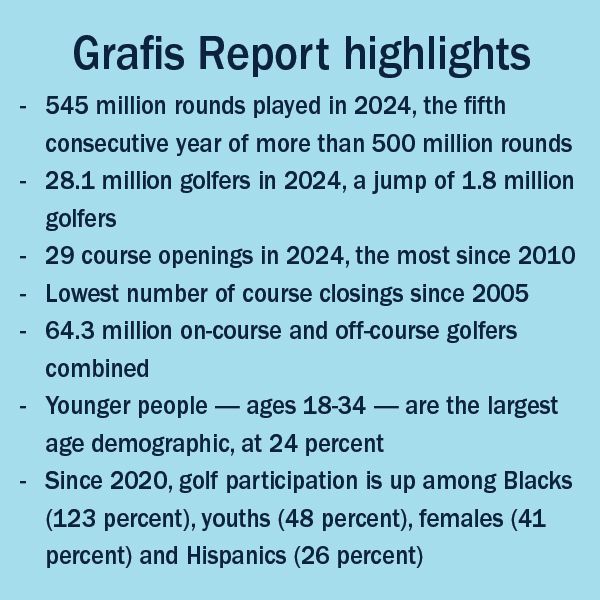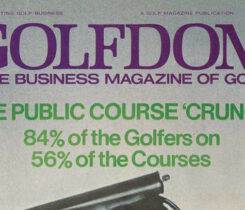A closer look at the 2025 Graffis Report
Earlier this year, the National Golf Foundation released its Graffis Report, which serves the NGF’s members as an annual report on golf’s economy. The Graffis Report is named after NGF founders Herb and Joe Graffis, two golf trailblazers who also founded Golfdom magazine and the Club Managers Association of America.
This year’s Graffis Report was particularly notable because the good news was so abundant. According to the report, 28.1 million people played “green-grass golf” in 2024, the biggest number since 2008, continuing a seven-year streak of upward trends. The 1.8 million jump in the number of golfers from 2023 to 2024 was the largest single-year increase since 2000, when the market was enjoying the Tiger boom. And the game saw the fewest number of course closures since 2005.

Golfdom sat down with NGF president and CEO Greg Nathan to discuss this year’s Graffis Report, what it means to those who work in the industry (particularly those trying to keep the course maintained for those record number of players) and what are some of the reasons for the vitality of the game.
Golfdom: Greg, a little shout-out to the Graffis brothers, because we have that common link between the NGF and the magazine. You just released the Graffis Report, and I think everyone would agree that the results were just outstanding. What are some of the things in the report that you see that you find most exciting?
Greg Nathan: There’s just such generational positivity around our game right now. I’ve been here 18 years at the NGF, it’s such a different place right now relative to when I started in 2007. When I look at the metrics, it almost makes me a little uneasy just in terms of how, across the board, the numbers are so positive. We certainly embrace them.
The engagement in our game is so strong right now. There are a couple of things in the Graffis Report that I would call out, like in 2024, 137 million Americans either played, followed, read about or watched golf; 137 million Americans! That’s above 40 percent of all Americans. Golf is becoming so ubiquitous. Golf’s growth and social media have really changed golf’s image. Previously, there was so much negativity around golf. Golf’s brand and image are in such a better place today.

Golfdom: How do you feel about these numbers maintaining their current trends? What are the threats to the popularity of the game?
Nathan: We don’t see a lot of signs in the data that would indicate this is not sustainable. I think the biggest threats right now are things that are beyond our control — things like recession or geopolitical events.
Golfdom: For my readers, with the number of rounds played skyrocketing — a record 545 million rounds played in 2024 — is this a little bit of good news, bad news? Good for the cash register, but difficult to get the job done?
Nathan: There’s no doubt that when golf courses are super busy, it’s stressful. It stresses out the turf, it certainly stresses out the people. I have great sympathy for the long hours and often thankless situation that many of the folks in the greenkeeping community are in — but this is what we hope for in so many ways. I would say that, from my point of view, the most successful segment for the past several years is not clubs and balls, it’s not software, it’s not golf cars. It’s golf facilities. That’s the segment that’s the healthiest.
We’ve measured the financial health of golf courses six times since 2009, and the level of the percentage of private and public golf courses that say they are financially healthy, it’s gone from a third of courses to 70 percent of courses. What that means for a superintendent’s crew is more money to buy equipment, more money to buy chemicals. It doesn’t necessarily mean they’re going to get to work less, but it might create opportunities for them to make a little bit more money. It might create opportunities to grow staff.
We have no choice but to embrace it because the alternative is less job security and less future opportunity.
Golfdom: The Graffis Report also tracks the growing number of “off-course” golfers, people who play golf on simulators or at facilities like Topgolf. How important are these golfers to the people who run green-grass golf facilities?
Nathan: Really important. There is not a sport or activity that exists in the world that wouldn’t give their left pinky toe to have 30-million-plus people participating in an activity that’s near the traditional activity.
What’s important is hitting a real ball with a real club with a full swing. Because only when you do that can you get golf’s drug, golf’s addictive drug, which we call “shot euphoria.” When you can get shot euphoria, that’s the hook. It is already benefiting (the game). That’s one of the areas that’s changing golf’s image. But it’s also the on-ramp to traditional golf. It’s the bridge between the couch and the course.
Golfdom: During the NGF Annual Meeting, you talked about the Tiger boom and what Tiger did for golf in his heyday. And now, since COVID, we’re in this new golf boom. You talked about how the Tiger boom came to a halt, and how this boom is much different. Do you mind going down that rabbit hole for me a little bit and expounding on that?
Nathan: You alluded at the very beginning … I think it’s seven straight years of growth in the number of green-grass participants. We’re at 28.1 million golfers. The high-water mark in green-grass golfers was around 2003, 2004 at 30.6 million. When you look back at that period of time — the ‘Tiger Slam,’ the incredible performance at the U.S. Open at Pebble Beach — we had this participation bubble.
But when the recession hit, a lot of the growth back then came from less committed, less frequent players, and many of them disappeared. We saw a trough form in terms of the decline for many years in green-grass golf participation.
One of the things about the growth we’ve been experiencing since the pandemic is a disproportionate amount of growth in less frequent, less committed players. We have to pay close attention to that parallel. I don’t believe that the numbers dictate that we’re heading for a trough coming off this rise in less committed, less frequent golfers. It’s a different time today. Back in the Tiger boom era, we didn’t have 35 million people playing off-course. We didn’t have the boom in screen golf and gamified ranges and Top Golf. Golf wasn’t nearly as cool as it is now. Tiger was cool, but recreational golf’s image has changed so much due to the presence of social media, and that’s made golf more intellectually accessible. They’re wearing different clothes, these people are individuals; they’re not the same type of person.
There are some parallels in the way the growth is materializing, but we’re in a very different day as it relates to golf’s image and the total golf participation between on and off being so high.
Golfdom: What do you think Herb Graffis would say to you and me today about what we’re experiencing in the game?
Nathan: Seth, I always say to you when I see you that we’re brothers from the same father. I know he’d be absolutely blown away. He had the vision. When I give my speeches, and I put their picture up on the screen, what I talk about are these two brothers from Chicago who, when golf was purely a private game in America, they looked at it, and they could see that golf was going to be big business in America. Golf was going to be part of the American dream. And if they had any idea that we’re going to approach, in the next 10 years, 50 percent of Americans playing, watching, reading, following golf, they would be like, “OK, our vision has exceeded every expectation that we could have had for it.”
Golfdom: Well, I’m grateful for those guys, and I’m grateful for you guys. It’s great that we get to keep these traditions going. Going into this golf season, I just have to appreciate where the game is because it’s going to get really busy for a lot of people. And that’s a good thing.
Nathan: It’s a very good thing.










